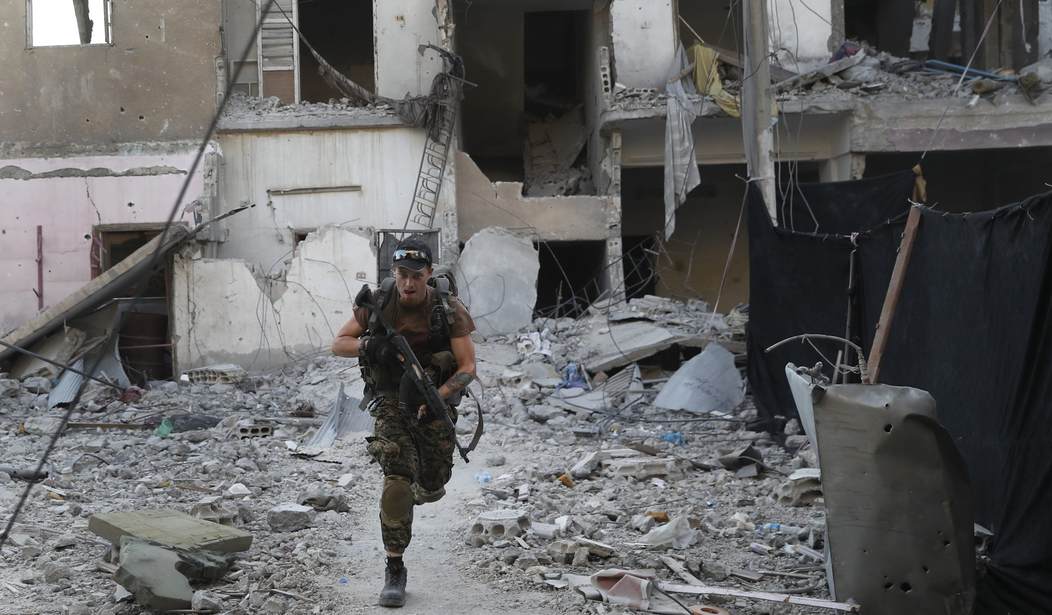ARLINGTON, Va. — The Pentagon said today they’re concerned about cases such as a female ISIS suicide bomber slipping in among a group of fleeing civilians, but they’re also assessing the risk of besieged terrorists slipping out of Raqqa to another part of the world as “very low.”
Col. Ryan Dillon, spokesman for Operation Inherent Resolve, told reporters via video from Baghdad that fighting in ISIS’ Syrian capital “continues to be intense, as fanatical ISIS dead-enders and foreign terrorist fighters left to die use the dense urban environment to try to cling to territory.”
The multi-ethnic, multi-sectarian Syrian Democratic Forces control about 45 percent of Raqqa. The overall operation that cleared hundreds of square miles in the drive toward the Syrian city began in November.
More than 80 percent of the ISIS attacks on the SDF have been committed with improvised explosive devices as the coalition of Kurds, Arabs, Assyrians, Yazidis and other ethnic minorities “are clawing away at remaining hiding places” used by ISIS, Dillon said.
The SDF has been plunging into the city from all directions, and the east and west flanks are now about 250 meters apart.
“Civilians who remain in Raqqa are also being targeted by ISIS. In the west of the city, a female terrorist joined a stream of 500 noncombatants who were being evacuated by the SDF and detonated a suicide vest. ISIS also indiscriminately fired on the evacuating crowds, causing casualties including those of the rescuing SDF,” Dillon said. “Throughout cleared areas of the city, the Raqqa Internal Security Forces, otherwise known as the RISF, a local volunteer counter-ISIS force comprised mostly of Arabs, continues to take on the role of providing order and preventing the escape of, or return of, terrorists.”
This week, 230 new members graduated from RISF training with courses in weapons, first aid, regulations and security screening.
One of the most dangerous things ISIS leaves in its wake: booby traps.
“Territory must be cleared of ISIS fighters and cleared of the tons of explosives that have been left behind by these jihadists. We know the immense amounts of explosives ISIS has used in their defenses throughout Iraq. We’ve seen that they have purposely left, in places like Fallujah and Ramadi, booby traps that they’ve left in ovens, in closets, in dresser drawers, as some examples,” Dillon said.
“I was talking to a colleague yesterday from the embassy here, of an Iraqi family he talked about that returned to their house in Mosul and when they flipped on a light switch, it triggered a bomb in their neighbor’s apartment, killing several members of that family,” he added.
Dillon was asked if the coalition is seeing ISIS fighters fleeing Syria for other ISIS hubs, such as central and southeast Asia.
“As we have that completely surrounded and isolated, if there are fighters there, they’re — it’s going to be very, very difficult for them to leave Raqqa,” the colonel replied. “Similarly, elsewhere throughout Syria and Iraq, where we have Tal Afar, again isolation around that.”
“…Between those countries, between Interpol and other organizations like that, the ability for fighters to come into and out of Iraq and Syria has been hampered significantly. And I don’t have numbers, but those that are in Iraq and Syria right now, their chances of leaving are very low. Their chances of dying in Iraq and Syria are very high.”









Join the conversation as a VIP Member